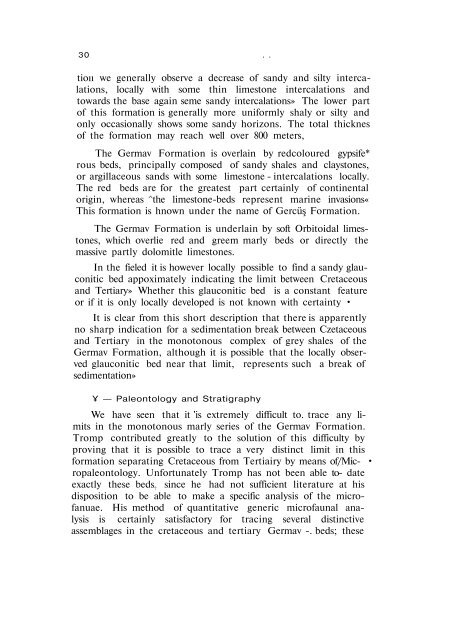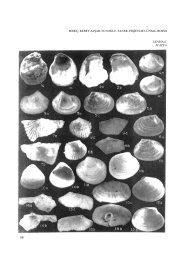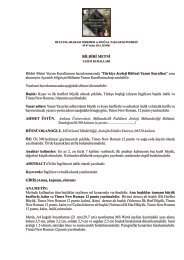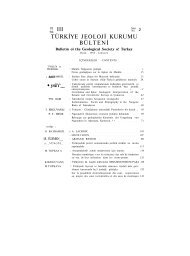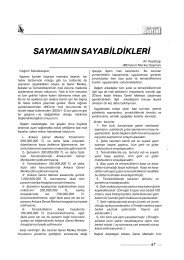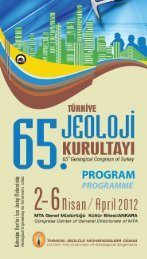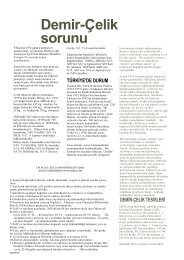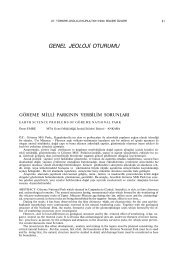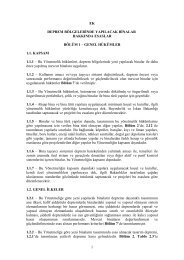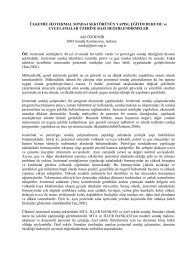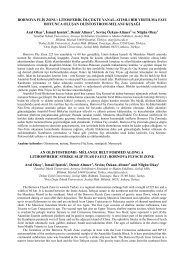Cenub DoÄu Türkiye'de Tersiyer-Kretase'Hududu
Cenub DoÄu Türkiye'de Tersiyer-Kretase'Hududu
Cenub DoÄu Türkiye'de Tersiyer-Kretase'Hududu
You also want an ePaper? Increase the reach of your titles
YUMPU automatically turns print PDFs into web optimized ePapers that Google loves.
30 . .<br />
tioıı we generally observe a decrease of sandy and silty intercalations,<br />
locally with some thin limestone intercalations and<br />
towards the base again seme sandy intercalations» The lower part<br />
of this formation is generally more uniformly shaly or silty and<br />
only occasionally shows some sandy horizons. The total thicknes<br />
of the formation may reach well over 800 meters,<br />
The Germav Formation is overlain by redcoloured gypsife*<br />
rous beds, principally composed of sandy shales and claystones,<br />
or argillaceous sands with some limestone - intercalations locally.<br />
The red beds are for the greatest part certainly of continental<br />
origin, whereas ^the limestone-beds represent marine invasions«<br />
This formation is hnown under the name of Gercüş Formation.<br />
The Germav Formation is underlain by soft Orbitoidal limestones,<br />
which overlie red and greem marly beds or directly the<br />
massive partly dolomitle limestones.<br />
In the fieled it is however locally possible to find a sandy glauconitic<br />
bed appoximately indicating the limit between Cretaceous<br />
and Tertiary» Whether this glauconitic bed is a constant feature<br />
or if it is only locally developed is not known with certainty •<br />
It is clear from this short description that there is apparently<br />
no sharp indication for a sedimentation break between Czetaceous<br />
and Tertiary in the monotonous complex of grey shales of the<br />
Germav Formation, although it is possible that the locally observed<br />
glauconitic bed near that limit, represents such a break of<br />
sedimentation»<br />
¥ — Paleontology and Stratigraphy<br />
We have seen that it 'is extremely difficult to. trace any limits<br />
in the monotonous marly series of the Germav Formation.<br />
Tromp contributed greatly to the solution of this difficulty by<br />
proving that it is possible to trace a very distinct limit in this<br />
formation separating Cretaceous from Tertiairy by means of/Mic- •<br />
ropaleontology. Unfortunately Tromp has not been able to- date<br />
exactly these beds ?<br />
since he had not sufficient literature at his<br />
disposition to be able to make a specific analysis of the microfanuae.<br />
His method of quantitative generic microfaunal analysis<br />
is certainly satisfactory for tracing several distinctive<br />
assemblages in the cretaceous and tertiary Germav -. beds; these


